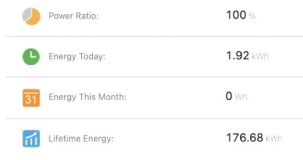So he made a new (and far clearer) video...
Thanks for posting, it was interesting.
All grid-tied inverters are going to have capacitors on the AC side, so every inverter (not just microinverters) should have the same issues. Really nice that the math added up with the three 330 nF capacitors.
Wonder how it compares with a comparable 8 kW string inverter? Has anyone tested this?
It strikes me that much of the conversation is about IQ8s rather than the previous generations of microinverter. For example, I've never experienced the bit at 25 minutes with my IQ7s where he says they can stay on at night and do updates or provide power factoring for the microgrid. My updates always come during daylight hours and they always lose communication at sundown. AFAIK only the IQ8s are bidirectional. If anyone has experienced IQ7s being bidirectional or getting updates at night please post about it.
The 15 µA consumption of standby current he got from Enphase is interesting. It seems ridiculously low when compared to other inverters. It's too low from my measurements yesterday (although, those measurements do include powering the other devices in the IQ battery (e.g., BMU, control board, communications, LEDs). Guess it's possible that's just the IQ8 portion.
...So yea, not eating the full reactive power figure from the battery but still eating some part of that.
From his video he thinks the battery losses are copper losses (which since it's less than 1/2 watt I'll just ignore) and the inverter efficiency which seems to be the big hitter. For his system it's 1.1 amp at 245V = 270W x 0.04 ~= 10W. For a 16 hour night, that's 160 Wh on his system.
Unfortunately, that's too low to measure accurately with the test in
#67 (earlier it was reported as 270W which would easily be measurable). Still curious as to what it really is. I do have a CT on the PV inputs, but it shows 0 at night time via the Enphase tools. Of course, I also have IQ7s so it could be different.
I doubt it would actually be as high as 160 Wh as he stated because there are capacitors in the battery's inverter too... so isn't most of the energy just reflected around? That is the actual battery power is only supplying the copper loss plus capacitor losses with the inverter inefficiency penalty?
Ideally, the way to measure it would be to get current reading from the DC side. I won't get around to that until the next decade when the warranty is expired. ; -) Might be raw data available if I ever get around to cracking the zigbee API.
If anyone has thoughts on how to measure it I'd love to hear them.
Q-Relays
That bit at the end was interesting. In the US the microinverters are UL 1741 compatible, so no additional devices needed. But, in Australia to accomplish what sounds like the same thing, rather than reprogram the voltages/frequencies/times Enphase already has for UL1741 into a special AU profile; they make their customers buy a Q Relay.
I suspect the decision was made that way as they found a device they could rebrand and it was cheaper and faster than software development and AU lab testing. But it's sad that it's needed as it seems like another point of failure.










